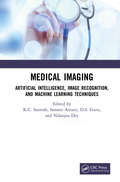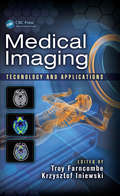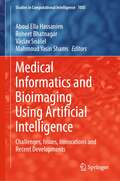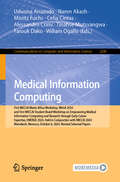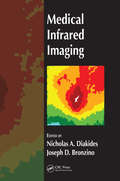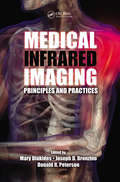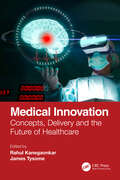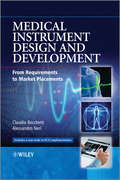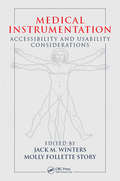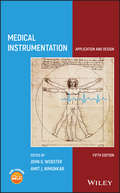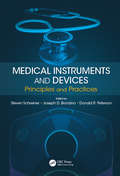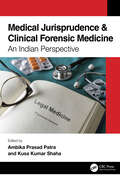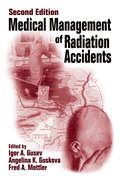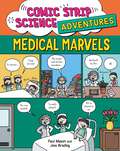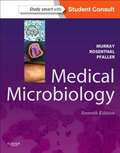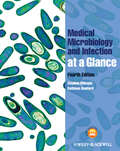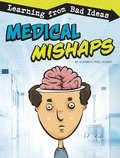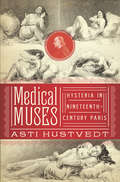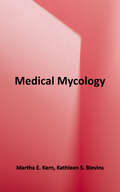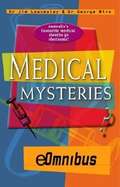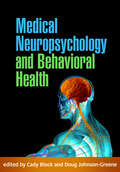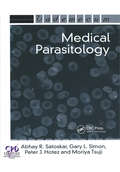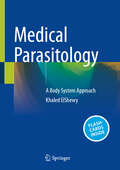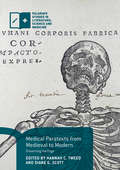- Table View
- List View
Medical Imaging: Artificial Intelligence, Image Recognition, and Machine Learning Techniques (Advances in Intelligent Systems and Computing #651)
by Nilanjan Dey K. C. Santosh D. S. Guru Sameer AntaniThe book discusses varied topics pertaining to advanced or up-to-date techniques in medical imaging using artificial intelligence (AI), image recognition (IR) and machine learning (ML) algorithms/techniques. Further, coverage includes analysis of chest radiographs (chest x-rays) via stacked generalization models, TB type detection using slice separation approach, brain tumor image segmentation via deep learning, mammogram mass separation, epileptic seizures, breast ultrasound images, knee joint x-ray images, bone fracture detection and labeling, and diabetic retinopathy. It also reviews 3D imaging in biomedical applications and pathological medical imaging.
Medical Imaging: Principles and Practices
by Joseph D. Bronzino Donald R. Peterson Mostafa AnalouiThe discovery of x-ray, as a landmark event, enabled us to see the "invisible," opening a new era in medical diagnostics. More importantly, it offered a unique undestanding around the interaction of electromagnetic signal with human tissue and the utility of its selective absorption, scattering, diffusion, and reflection as a tool for understanding
Medical Imaging: Technology and Applications (Devices, Circuits, and Systems)
by Alice Wilmere Norton ShawThe book has two intentions. First, it assembles the latest research in the field of medical imaging technology in one place. Detailed descriptions of current state-of-the-art medical imaging systems (comprised of x-ray CT, MRI, ultrasound, and nuclear medicine) and data processing techniques are discussed. Information is provided that will give interested engineers and scientists a solid foundation from which to build with additional resources. Secondly, it exposes the reader to myriad applications that medical imaging technology has enabled.
Medical Informatics and Bioimaging Using Artificial Intelligence: Challenges, Issues, Innovations and Recent Developments (Studies in Computational Intelligence #1005)
by Václav Snášel Aboul Ella Hassanien Roheet Bhatnagar Mahmoud Yasin ShamsThis book emphasizes the latest developments and achievements in artificial intelligence and related technologies, focusing on the applications of artificial intelligence and medical diagnosis. The book describes the theory, applications, concept visualization, and critical surveys covering most aspects of AI for medical informatics.
Medical Information Computing: First MICCAI Meets Africa Workshop, MImA 2024, and First MICCAI Student Board Workshop on Empowering Medical Information Computing and Research through Early-Career Expertise, EMERGE 2024, Held in Conjunction with MICCAI 2024, Marrakesh, Morocco, October 6, 2024, Revised Selected Papers (Communications in Computer and Information Science #2240)
by Alessandro Crimi Celia Cintas Udunna Anazodo Naren Akash Moritz Fuchs Tinahse Mutsvangwa Farouk Dako Willam OgalloThis book presents a series of revised papers selected from the First MICCAI Meets Africa Workshop, MImA 2024, and First MICCAI Workshop on Empowering Medical Information Computing and Research through Early-Career Expertise, EMERGE 2024, which was held in Marrakesh, Morocco, during October 6, 2024. MImA 2024 accepted 21 full papers from 45 submissions; for EMERGE 8 papers are included from 9 submissions. They describe cutting-edge research from computational scientists and clinical researchers working on a variety of medical image computing challenges relevant to the African and broader global contexts, as well as emerging techniques for image computing methods tailored to low-resource settings.
Medical Infrared Imaging
by Joseph D. Bronzino Nicholas A. DiakidesRapid evolution of technical advances in infrared sensor technology, image processing, ‘smart algorithms, databases, and system integration paves the way for new methods of research and use in medical infrared imaging. These breakthroughs permit easy-to-use, high-sensitivity imaging that can address key issues of diagnostic specificity and engende
Medical Infrared Imaging: Principles and Practices
by Joseph D. Bronzino Donald R. Peterson Mary DiakidesThe evolution of technological advances in infrared sensor technology, image processing, "smart" algorithms, knowledge-based databases, and their overall system integration has resulted in new methods of research and use in medical infrared imaging. The development of infrared cameras with focal plane arrays no longer requiring cooling, added a new
Medical Innovation: Concepts, Delivery and the Future of Healthcare
by James Tysome Rahul KanegaonkarAn essential text for innovators, this accessible book explains how medical and healthcare professionals and students who are new to innovation in healthcare can best progress their innovation projects and how those interested in healthcare innovation can develop an improved understanding of novel treatments and developments. The book provides a clear framework for the innovation pathway, describing step-by-step how projects are taken from concept to marketing, and also includes a current assessment of emerging technologies that will influence medical innovation in the future. Key Features: Wide-ranging and comprehensive coverage of the field, from digital health and AI technologies, through stem-cell applications and robotic surgery, to specialty-specific innovations including those in cardiology, public health and ophthalmology Illustrated with real-life examples of success and failure and what can be learned from these projects Reflects a greater emphasis on clinical innovation within health systems and its inclusion in undergraduate and postgraduate medical curriculae and medically related courses Supports national and international initiatives to encourage innovation in healthcare and maximize the novel ideas generated by university staff and students, as well as practicing clinicians Ideal for students at both undergraduate and postgraduate level and medical practitioners and allied medical health professionals, it will also be of interest to clinical innovators and healthcare businesses seeking to increase uptake of their products both in the UK and internationally.
Medical Instrument Design and Development
by Claudio Becchetti Alessandro NeriThis book explains all of the stages involved in developing medical devices; from concept to medical approval including system engineering, bioinstrumentation design, signal processing, electronics, software and ICT with Cloud and e-Health development. Medical Instrument Design and Development offers a comprehensive theoretical background with extensive use of diagrams, graphics and tables (around 400 throughout the book). The book explains how the theory is translated into industrial medical products using a market-sold Electrocardiograph disclosed in its design by the Gamma Cardio Soft manufacturer.The sequence of the chapters reflects the product development lifecycle. Each chapter is focused on a specific University course and is divided into two sections: theory and implementation. The theory sections explain the main concepts and principles which remain valid across technological evolutions of medical instrumentation. The Implementation sections show how the theory is translated into a medical product. The Electrocardiograph (ECG or EKG) is used as an example as it is a suitable device to explore to fully understand medical instrumentation since it is sufficiently simple but encompasses all the main areas involved in developing medical electronic equipment. Key Features:Introduces a system-level approach to product designCovers topics such as bioinstrumentation, signal processing, information theory, electronics, software, firmware, telemedicine, e-Health and medical device certificationExplains how to use theory to implement a market product (using ECG as an example)Examines the design and applications of main medical instrumentsDetails the additional know-how required for product implementation: business context, system design, project management, intellectual property rights, product life cycle, etc.Includes an accompanying website with the design of the certified ECG product (www.gammacardiosoft.it/book)Discloses the details of a marketed ECG Product (from Gamma Cardio Soft) compliant with the ANSI standard AAMI EC 11 under open licenses (GNU GPL, Creative Common)This book is written for biomedical engineering courses (upper-level undergraduate and graduate students) and for engineers interested in medical instrumentation/device design with a comprehensive and interdisciplinary system perspective.
Medical Instrumentation: Accessibility and Usability Considerations
by Jack M. Winters Molly Follette StoryTwo of the most important yet often overlooked aspects of a medical device are its usability and accessibility. This is important not only for health care providers, but also for older patients and users with disabilities or activity limitations. Medical Instrumentation: Accessibility and Usability Considerations focuses on how lack of usabi
Medical Instrumentation: Application and Design
by John G. Webster Amit J. NimunkarProvides a comprehensive overview of the basic concepts behind the application and designs of medical instrumentation This premiere reference on medical instrumentation describes the principles, applications, and design of the medical instrumentation most commonly used in hospitals. It places great emphasis on design principles so that scientists with limited background in electronics can gain enough information to design instruments that may not be commercially available. The revised edition includes new material on microcontroller-based medical instrumentation with relevant code, device design with circuit simulations and implementations, dry electrodes for electrocardiography, sleep apnea monitor, Infusion pump system, medical imaging techniques and electrical safety. Each chapter includes new problems and updated reference material that covers the latest medical technologies. Medical Instrumentation: Application and Design, Fifth Edition covers general concepts that are applicable to all instrumentation systems, including the static and dynamic characteristics of a system, the engineering design process, the commercial development and regulatory classifications, and the electrical safety, protection, codes and standards for medical devices. The readers learn about the principles behind various sensor mechanisms, the necessary amplifier and filter designs for analog signal processing, and the digital data acquisition, processing, storage and display using microcontrollers. The measurements of both cardiovascular dynamics and respiratory dynamics are discussed, as is the developing field of biosensors. The book also covers general concepts of clinical laboratory instrumentation, medical imaging, various therapeutic and prosthetic devices, and more. Emphasizes design throughout so scientists and engineers can create medical instruments Updates the coverage of modern sensor signal processing New material added to the chapter on modern microcontroller use Features revised chapters, descriptions, and references throughout Includes many new worked out examples and supports student problem-solving Offers updated, new, and expanded materials on a companion webpage Supplemented with a solutions manual containing complete solutions to all problems Medical Instrumentation: Application and Design, Fifth Edition is an excellent book for a senior to graduate-level course in biomedical engineering and will benefit other health professionals involved with the topic.
Medical Instruments and Devices: Principles and Practices
by Joseph D. Bronzino Donald R. Peterson Steven SchreinerMedical Instruments and Devices: Principles and Practices originates from the medical instruments and devices section of The Biomedical Engineering Handbook, Fourth Edition. Top experts in the field provide material that spans this wide field. The text examines how biopotential amplifiers help regulate the quality and content of measured signals. I
Medical Jurisprudence & Clinical Forensic Medicine: An Indian Perspective
by Mba Frcp Md Dr Ambika Prasad Patra And Dr Kusa Kumar Shaha Ffflm Professor (additional) & Head of Department Faculty Of Medicine Department of Forensic Medicine & Toxicology Jawaharlal Institute of Post-graduate Medical Education & Research India; Member of International Academy of Legal Medicine of Switzerland; Faculty member (by equivalent qualification) of Forensic & Legal Medicine of London; Member of Indian Academy of Forensic Medicine & Indian Society of Toxicology (ex-officio). Dr Kusa Kumar Shaha MbbsThis book on Medical Jurisprudence & Clinical Forensic Medicine addresses the evolving nature of law and medicine. It updates the medicolegal (ML) systems and discusses the concerns related to digitalization of courts, serving a subpoena through social media, ethical/ML issues in nanomedicine, telemedicine and online prescription practices, toxicology and mass disaster. It fulfils the increased demands of students, forensic medicine specialists, clinicians and lawyers to get authentic medicolegal information in situations of ethical dilemma or during ML urgencies. It features case-based discussions on ML and deontological issues supported by the latest legal/statutory information. Key Features:• Discusses the clinical and applied aspects of forensic medicine through illustrative case scenarios and reports.• Addresses the needs of clinicians and forensic medicine specialists in writing medico-legal reports for specific cases.• Provides evidence-based solutions to medicolegal and ethical dilemma faced during routine practice.
Medical Management of Radiation Accidents
by Kenneth S. CohenAlthough radiation accidents are rare and often complex in nature, they are of great concern not only to the patient and involved medical staff, but to the media and public as well. Yet there are few if any comprehensive publications on the medical management of radiation accidents. Medical Management of Radiation Accidents provides a complete refe
Medical Marvels (Comic Strip Science Adventures #4)
by Paul MasonAn entertaining collection of comic strip stories uncovering some amazing advances in medicine.Discover how Charles Drew saved millions by storing blood plasma, how a Chinese scientist discovered a malaria treatment and much more. This book is sure to entertain children, while giving them an insight into the many challenges and rivalries behind scientific achievements and how scientists learn from mistakes. It is produced by the same team as Comic Strip Science with hilarious comic strips illustrated by award-winning artist Jess Bradley and written by Paul Mason, who is well known for making science learning fun. Key science concepts are pulled out in more depth in feature spreads. The book has a specialist text consultant Dr Anna Simmons, UCL.Comic Strip Science Adventures is a series of comic books that are perfect for young scientists aged 7 plus. Each book has specialist subject consultants. Titles in the series: Digging for Dinosaurs, Exploring Space, Medical Marvels, Amazing Inventions.
Medical Microbiology
by Patrick R. Murray Ken S. Rosenthal Michael A. PfallerThis book is written in a straightforward manner with, it is hoped, uncomplicated explanations of difficult concepts. Details are summarized in tabular format rather than in lengthy text, and there are colorful illustrations for the visual learner. Clinical Cases provide the relevance that puts reality into the basic science. Important points are emphasized in boxes to aid students, especially in their review; and the study questions, including Clinical Cases, address relevant aspects of each chapter. Each section begins with a chapter that summarizes microbial diseases, and this also provides review material. The authors used their experience also as teachers to choose the most important information and explanations for inclusion in this textbook. Each chapter has been carefully updated and expanded to include new, medically relevant discoveries. In each of these chapters, the authors have attempted to present the material that will help the student gain a clear understanding of the significance of the individual microbes and their diseases.
Medical Microbiology and Infection at a Glance
by Stephen Gillespie Kathleen BamfordThis concise and popular introduction to medical microbiology and infection encapsulates the fundamental facts and principles of this rapidly growing and changing subject area. Written by experienced clinicians and teachers, it covers the basic concepts of medical microbiology, and the main human pathogens and infectious syndromes, in an accessible and lucid format. This fully updated fourth edition is now supported by a companion website at www. ataglanceseries. com/medicalmicrobiology containing extra self-assessment cases, colour slides, further reading, and key point summaries. Medical Microbiology and Infection at a Glance is an invaluable revision aid for medical and allied health students and junior doctors, and is ideal for anyone seeking a comprehensive and concise guide to this subject area.
Medical Mishaps: Learning from Bad Ideas (Fantastic Fails)
by Elizabeth Pagel-HoganSee some of the world's most messed-up medical mishaps at a microscopic level. Find out how each procedure, tool, or surgery failed, the basic science that was missed, and what doctors learned from their mistakes.
Medical Muses: Hysteria in Nineteenth-Century Paris
by Asti HustvedtA fascinating study of three young female hysterics who shaped our early notions of psychology. Blanche, Augustine, and Genevieve found themselves in the hysteria ward of the Salpetriere Hospital in 1870s Paris, where their care was directed by the prominent neurologist Jean-Martin Charcot. They became medical celebrities: every week, eager crowds arrived at the hospital to observe their symptoms; they were photographed, sculpted, painted, and transformed into characters in novels. The remarkable story of their lives as patients in the clinic is a strange amalgam of intimate details and public exposure, science and religion, medicine and the occult, hypnotism, love, and theater. But who were Blanche, Augustine, and Genevieve? What role did they play in their own peculiar form of stardom? And what exactly were they suffering from? Hysteria--with its dramatic seizures, hallucinations, and reenactments of past traumas--may be an illness of the past, but the notions of femininity that lie behind it offer insights into disorders of the present.
Medical Mycology: A Self-instructional Text
by Martha E. Kern Kathleen S. Blevins- Each of the seven modules includes prerequisites, content outline, objectives, follow-up activities, references, and self-study examinations - Teaches proper laboratory practice and presents the biology and physiology of fungi, describing the epidemiology of fungal infections, defining fungal disease states, and emphasizing laboratory identification of fungi based on body sites - Test protocols and reagent recipes are highlighted in each module - Information about AIDS and immunocompromised patients has been added to the pertinent disease descriptions, following the discussion of causative organisms - Module 2 includes common techniques for fungal culture preservation, DNA testing for rapid identification, and antifungal therapeutics
Medical Mysteries eOmnibus
by Jim Leavesley George Biro3 books by 2 physicians who explore medical questions like what killed Jane Austin, did a mistake cause World War I, and did Freud use cocaine?
Medical Neuropsychology and Behavioral Health
by Cady Block Doug Johnson-GreeneIt is increasingly recognized that medical conditions can have a range of neurocognitive, psychosocial, and functional implications, even in the absence of obvious neurological involvement. Filling a gap in the literature, this comprehensive clinical reference reviews current research and provides clear guidelines for assessment and intervention. Chapters organized around major bodily systems--for example, cardiovascular, endocrine, immune/lymphatic--probe neurocognitive impairments associated with prevalent health conditions and their treatments, including coverage of COVID-19. State-of-the-science chapters on lifestyle behaviors and habits explore the neurocognitive impact of sleep and fatigue, nutrition and weight, acute and chronic pain (and the use of opioid analgesics), personality and temperament, and substance misuse.
Medical Parasitology
by Abhay R. Satoskar Gary L. Simon Peter J. Hotez Moriya TsujiInfections caused by parasites are still a major global health problem. Although parasitic infections are responsible for a significant morbidity and mortality in the developing countries, they are also prevalent in the developed countries. Early diagnosis and treatment of a parasitic infection is not only critical for preventing morbidity and mort
Medical Parasitology: A Body System Approach
by Khaled ElShewyThis book offers a concise and clear overview of medically important parasites. It sets itself apart from traditional parasitology systematic books by adopting an integrated modular system, which is currently being introduced in many countries. Parasites are categorized based on the body systems they infect. To avoid repetition, parasites with multisystem effects are grouped under the system they primarily infect, and they are cross-referenced in other relevant sections. The book thoroughly covers the various stages of a parasite's life cycle, modes of transmission, epidemiology, and diagnosis of parasitic diseases. To foster a better understanding of the connections between basic and clinical subjects, the text emphasizes the pathogenesis and subsequent clinical presentation of commonly encountered parasitic infections in humans. Moreover, the text includes current information on the ever-changing field of anti-parasitic treatment, serving as a valuable resource for practitioners. Each section is accompanied by endnotes that highlight key points, and review questions are provided to facilitate comprehension and review. The book's original drawings, tables, and colored diagrams are designed to simplify the understanding of pathogenesis and structural morphology. For those seeking additional details, structural morphology and dosages of anti-parasitic drugs are presented. The language is straightforward, making the book suitable for medical students and physicians alike, enabling them to approach more simplified literature with confidence. Additional questions and answers via app: Download the Springer Nature Flashcards app free of charge and use exclusive additional material to test your knowledge.
Medical Paratexts from Medieval to Modern: Dissecting The Page (Palgrave Studies in Literature, Science and Medicine)
by Hannah C. Tweed Diane G. ScottThis collection establishes the term ‘medical paratexts’ as a useful addition to medical humanities, book history, and literary studies research. As a relatively new field of study, little critical attention has been paid to medical paratexts. We understand paratext as the apparatus of graphic communication: title pages, prefaces, illustrations, marginalia, and publishing details which act as mediators between text and reader. Discussing the development of medical paratexts across scribal, print and digital media, the collection spans the medieval period to the twenty-first century. Dissecting the Page is structured in two thematic sections, underpinned by a shared examination of ideas of medical and lay readership and a history of reader response. The first section focuses on the production, reception, and use of medical texts. The second section analyses the role and significance of authority, access, and dissemination in discussions of health, medicine, and illness, for both lay and medical readerships.
